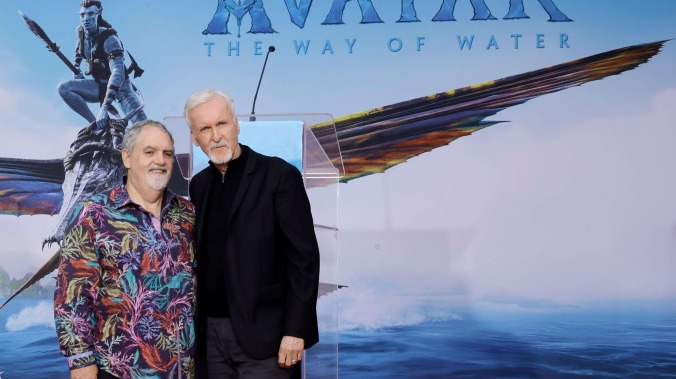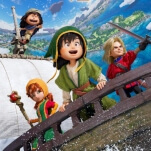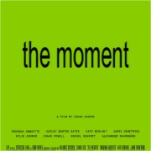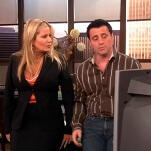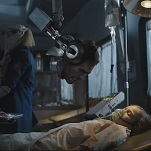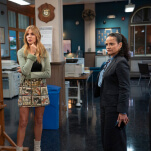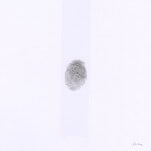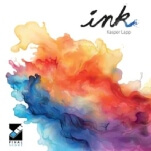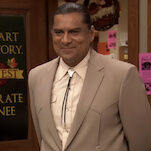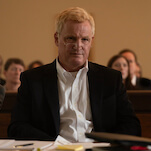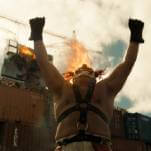Jon Landau and James Cameron Photo: Kevin Winter
James Cameron is still in the deep end. During a career that has reached from the ocean floor to deep space (and an ocean floor in deep space), the Oscar-winning director has grabbed audiences with his romantic, hopeful visions of the future and the past, creating worlds so convincing people will swear they’re real. With the $2.3 billion box office of Avatar: The Way Of Water and three more Pandora-based installments on the way, Cameron’s only getting started. Since 1997, he has been working with his producing partner, Jon Landau, and together they’ve made some of the most successful movies ever, defying expectations and cultural trends by creating endearing works of pop romance with virtuosic story sense and a mastery of cutting-edge visual effects.
Cameron’s work has never looked better, too. For the first time, Titanic, Avatar, Avatar: The Way Of Water, The Abyss, True Lies, and Aliens, are coming to 4K, with the movies hitting streamers next week. Additionally, in between releasing the new 4K UHD Blu-ray of Titanic (which hit shelves Tuesday), and the two Avatar films (coming December 19), he also premiered the long-awaited special edition of The Abyss.
We spoke to Cameron and Landau about those films, the importance of historical accuracy in movies, and Barbie.
AVC: You’ve returned to the deep many times, but considering all the difficulties of making movies on water, what compels you to keep doing it? Is it the challenge? And Jon, when he comes to you with the script, does the water ever concern you?
James Cameron: I love being underwater. I love being at sea. I know how difficult it’s going to be. Maybe subconsciously, I think we’ll do it because we can and others can’t, but there is a deep human fascination with underwater, with the imagery. And I think a 3D film, a science-fiction film taking place on another planet underwater, how cool is that? Titanic. I mean, you don’t need to tell people how cool that is. It’s just, “Yeah, let’s go see that.”
The Abyss was a little bit of a harder sell, and I hadn’t done any of my actual deep exploration at that point. I was just getting used to the kind of the tools, the remotely operated vehicles and the submersibles, the sort of science and technology of it at that point. But once I made The Abyss, there was no turning back. I had to go, like, really go to the real abyss. Ultimately, in 2012, I went to a place beyond the abyss, called the Hadal depths. The abyss ends at 6,000 meters. But there’s another, you know, 4,000 to 5,000 meters of depth to go to where people haven’t looked. I guess I went all the way to the deep end of the pool.
Jon Landau: For me, when I read something like Titanic, honestly, I don’t even think about the water. I am so wrapped up in the characters’ story. The water is secondary because I know that we’re going to figure out how to do whatever the production issues are.
When I read something like Way Of Water and [James says], “Jon, it’s more water.” I go, “I want more water. Bring more water.” Because I’m a diver, I love scuba diving and being able to share that experience with other people. I think that’s what Avatar: The Way Of Water does: People feel like they are going on their first dive underwater.
JC: Yeah, we wanted to make it palpable, tangible. The thing is, you know the challenges going in. So we started, literally, years in advance before we rolled the film on The Way Of Water, pumping tons of money, millions and millions of dollars into R&D to generate the best computer graphics simulations of water that were possible—far beyond anything that had been done before—because you have to understand the scope of the challenge in any one of these films. We started that process as early as possible, even before we were casting and all that sort of thing, creating those simulations. Then it all paid off in the final image because you can’t tell that that water is not real water. I can’t tell. I have to remind myself, “Oh yeah, that wasn’t real water.” Even though we shot in water, we didn’t photograph the water. We captured the motion of the performer and the facial performance. The water itself, we had no way of capturing. So it all had to be created later as a physics-based simulation.
AVC: Which one is easier to work with: digital water or real water?
JC: Well, I don’t get as wet! On The Abyss, for example, I was underwater 8 to 10 hours a day. The actors might have been underwater a couple of hours a day because we’d only bring them down when we were lit and ready and kind of rehearsed. On The Way Of Water, I was working dry. The actors were in the water, but I wasn’t. The reason for that is that my virtual camera actually gave me a better situational awareness and a better ability to deal with all the aspects above and below water than it would have been if I had actually been underwater with them. Having done both, I can say that that was absolutely the best way to do that. So on my virtual camera, I could see all the all the actors under the water as their characters in the world, with the coral, with the light, with the creatures.
JL: I would say you need both. Avatar: Way Of Water, we needed to capture our actors underwater water so they would feel the current. You react differently. Your body is different. People suggested to us, “Do a dry for wet.” Do these other things. No. Truth in performance. We needed the water. And then in the CG was the other element because we weren’t photographing our set. We needed that to create an immersive experience.
JC: True of all the films, Jon. I mean, on The Abyss, Mary Elizabeth Mastrantonio had to learn how to act inside a diving helmet. Everybody had to become, first of all, scuba certified, then helmet certified. Then they had to go down into the pitch-dark realm and and act. The same thing on Titanic. There were actual water scenes, water pouring down corridors, flooding, all near-drowning type types of things. It requires a commitment from the actors, and they don’t necessarily know how hard it’s going to be when they sign up for the gig.
JL: I remember a great moment came from Kate [Winslet] on Titanic, when we were in one of the flooded corridors, and she was going through it with the ax and she was struggling. When the take was over, she goes, “Yeah!”
JC: Because it was real. It felt real. I know the scene you’re talking about when she’s pulling herself along the pipe. That water was cold, too. She was not entirely acting when she went “brrr,” and her lips turned blue.
AVC: What is it like remastering all of these things at the same time, bouncing from Titanic to Pandora to The Abyss?
JC: The remasters have been done sequentially over time. It takes time and energy. We weren’t sort of driving toward a release of all six at once. That’s just sort of happened. All the value-added materials and featurettes have come together all at once. Then we just set a target date for the holidays and made that happen. But we have a great team. Geoff Burdick at Lightstorm is our vice president in charge of technical, but he also handles all this archival stuff, all the transfers. And we’ve got a great team at the studio at Disney that creates all the packaging and all that. It’s really a composite effort. I drop in for an intense period to do the transfer. The featurette materials are cut and shown to me, but Jon was more the driving force on all that stuff, at least on the films that he was involved with as a producer.
JL: We didn’t do this in one small window and rush it together. You know, as James said, the plan was done over a number of years. So, we started thinking about what we wanted to add. What’s the added value? Coming up with two brand new documentaries about The Abyss. A new one: “Fear Is Not An Option” is part of the True Lies release. I really love the title. It’s such a great message for everybody to think about. And on Avatar, to be able to look at things like the scene breakdowns.
JC: I love the scene breakdown because you really get to see the actor’s performances and how they translate through to the finished image and you see that it’s absolutely what they did, like at a molecular level. They become blue, they become 10 feet tall, they have cat ears, you know, and giant eyes and all that. But it’s literally exactly what Zoe [Saldaña] did, what Sam [Worthington] did, what Sigourney [Weaver] did. And Sigourney was 69, 70 when we were capturing her for The Way Of Water and for Avatar three. To see her as this 15-year-old character and to see that it is exactly what she did. It’s such a celebration of acting to see it.
In what we call “the scene deconstruction,” where you see all the stages that get you to that final image, we don’t like to show that stuff before we release the film. We don’t want people to see behind the scenes. We want them to believe that this place is real. We know it’s not real. But the second you see somebody in a black leotard marker suit with a head rig on, it’s like, how can you unsee that? But once you’ve gone on the experience of the movie, why not share the magic, the behind-the-scenes?
AVC: You spend much of the 2005 commentary for Titanic responding to criticisms of the film’s historicity and debunking myths. Historical accuracy is clearly very important to you. Right now, there’s a lot of debate over historical accuracy in film, especially with regard to Ridley Scott’s Napoleon. When you watch a movie, does historical inaccuracy take away from the experience?
JC: It does. If I watch a movie and I get excited about what I’m seeing, and I think, “Wow, that really happened.” And then I go read about it, and I’ve realized that they’ve taken all these liberties that sort of seduced me in the moment but turned out not to be true, I’ll never watch that film again.
I think it’s the opposite experience with Titanic. Titanic is such an amazing story. You don’t have to make things up. Obviously, we made up the foreground story of Jack and Rose and her family and all that sort of thing. But that was to give you a portal of entry into the world of Titanic and the real events of it. But when it came to showing what happened, we were rigorous. We were rigorous about what lifeboat launched, in what order, what time, who was where, and what officers were where. We went through thousands of pages of witness interviews and transcripts from the various investigations that were done afterward and all the history that was available. We had historians on board to check us. We went back. We tried to recreate the ship, the set down to the china and the lifejackets; everything was done with meticulous accuracy.
Now, there’s an interesting thing about history, which is if there wasn’t a video camera or a lot of surveillance cameras around, there would be a lot of gaps, and people’s memories tend to be inaccurate or fill things in. So we’re trying to piece together all this eyewitness testimony that sometimes didn’t agree, right? But, you know, fortunately, we went to the wreck and we did a really, really thorough forensic examination of the wreck as well. There were certain things that I put into the film that I believed happened and, for the most part, have been proven to be true based on subsequent investigations after the movie was made. Some of the things I put in the movie were actually controversial with so-called experts at the time and have proven to be accepted later. So, in a funny way, [Titanic] was a more precise and accurate history than what existed at the time because we had to stand it up and make it happen. We had to get that collapsible lifeboat off the roof onto the deck. Well, how the hell did they do it? Well, we had to figure it out. All of a sudden, that eyewitness testimony now starts to make sense as we went through that process of actually staging the entire thing.
AVC: With all you’re working on, have you two had any time to watch movies this year? Do you have any favorites?
JL: I dig Oppenheimer and The Creator. I thought what they were able to do visually with that was stunning.
JC: We see everything eventually. Maybe not right on the day of release. I still haven’t seen Napoleon. But of course, I always look forward to any new Ridley Scott film, so I’ll see it as quickly as I can. Oppenheimer, obviously. Barbie, I think, is amazing. It’s absolutely amazing. It’s amazing as a social phenomenon that a movie that seems to be about so little is about so much that’s important between men and women and the sort of dialog and the politicization of it. That is really kind of astonishing.
I’ve talked to Greta [Gerwig] a lot about it, and she knew exactly what she was doing, and she was going for something, and she pulled it off. And I think that’s really laudable.
